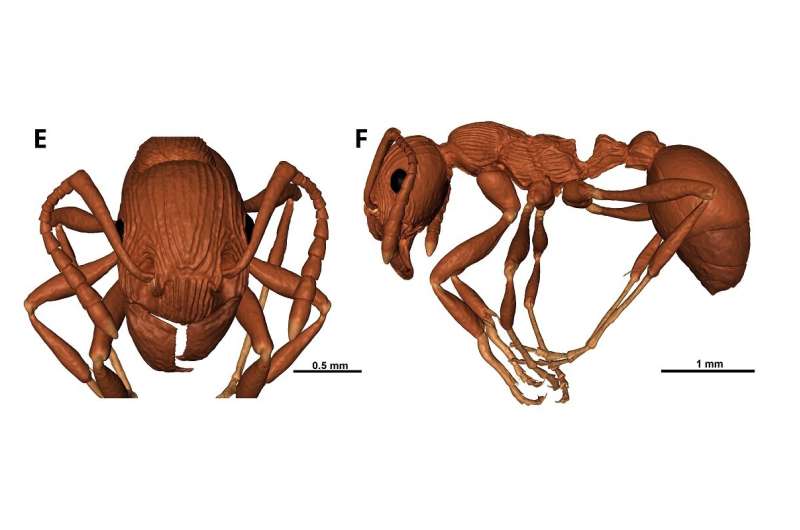Biologists discover the first fossil species of mountain ants in Baltic amber

St Petersburg University scientists found an ant of the genus Manica in a piece of amber in collection of the Kaliningrad Amber Museum. Such ants had previously been found only in the mountains of Europe, the Caucasus, North America, and Japan. The scientists report that the age of the finding is about 33.9–37.8 million years. This is the most ancient and first known fossil species of this genus.
Their research findings were published in Insects.
Manica is a genus of ants about 5–6 millimeters long, currently found exclusively in mountainous regions. Prior to this study, only six recent species of the genus Manica were known. Four of them inhabit the western part of North America, one is found in Japan, and another one lives in the mountains of Europe and the Caucasus. St Petersburg University scientists managed to discover a new member of the genus Manica in Baltic amber found in Kaliningrad, where these ants had not been seen before.
“The species we have described, Manica andrannae, is highly likely the ancestor of some modern taxa of ants from the largest ant subfamily Myrmicinae. This is the first such ancient finding of this genus in the fossil state and the first finding of this kind in Europe,” noted Dmitry Zharkov, the first contributor to the study, a young scientist in the Department of Applied Ecology at St Petersburg University.
Scientists suggest that the genus Manica originated in North America. During the Eocene epoch (from 56 to 33.9 million years ago), it was repeatedly connected with Eurasia by land corridors, through Beringia in the west, with Asia, and through the Thulean Bridge in the east, with Europe. It is likely that one of the ancestral species, having come from America to Asia via Beringia, formed the modern species Manica yessensis, which lives in the mountains of Japan.
Another part of the ancestors went east and, through the Thulean North Atlantic Bridge, came to Europe in the early Eocene. It is there that our scientists discovered Manica andrannae, the above-mentioned new fossil species.
The research was carried out using the resource centers of the St Petersburg University Research Park, namely the Center for Microscopy and Microanalysis and the Center for X-Ray Diffraction Studies.
According to the experts at St Petersburg University, the mentioned hypothesis is supported by a large number of studies. They have demonstrated that the European fauna of this period developed in isolation from the Asian one. During the Eocene period, Europe and Asia were separated by the Tethys Sea, which, apparently, was an insurmountable obstacle to animal dispersal.
Moreover, fossil insects similar to those inhabiting the New World today have been found in Baltic amber before. For example, in 2022, St Petersburg University biologists were the first to discover and describe another new fossil ant species of the Eocene period. It is titled Dolichoderus jonasi and it is related to the species typical of South and Central America.
The scientists were able to classify the finding due to a detailed analysis of its morphological features. They used an up-to-date method of computed microtomography. The scientists were able to digitize the ant in detail and create its 3D model. That made it possible to completely study all features of the fossil, while ignoring other elements that had got into the amber and interfered with the study of the sample, such as plant remains, air bubbles, and so on.
More information:
Dmitry Zharkov et al, The First Fossil Record of the Genus Manica Jurine, 1807 from Late Eocene Baltic Amber and Discussion of the Early Evolution of Myrmicini (Hymenoptera: Formicidae: Myrmicinae), Insects (2022). DOI: 10.3390/insects14010021
Citation:
Biologists discover the first fossil species of mountain ants in Baltic amber (2023, February 2)
retrieved 3 February 2023
from https://phys.org/news/2023-02-biologists-fossil-species-mountain-ants.html
This document is subject to copyright. Apart from any fair dealing for the purpose of private study or research, no
part may be reproduced without the written permission. The content is provided for information purposes only.
For all the latest Science News Click Here
For the latest news and updates, follow us on Google News.

